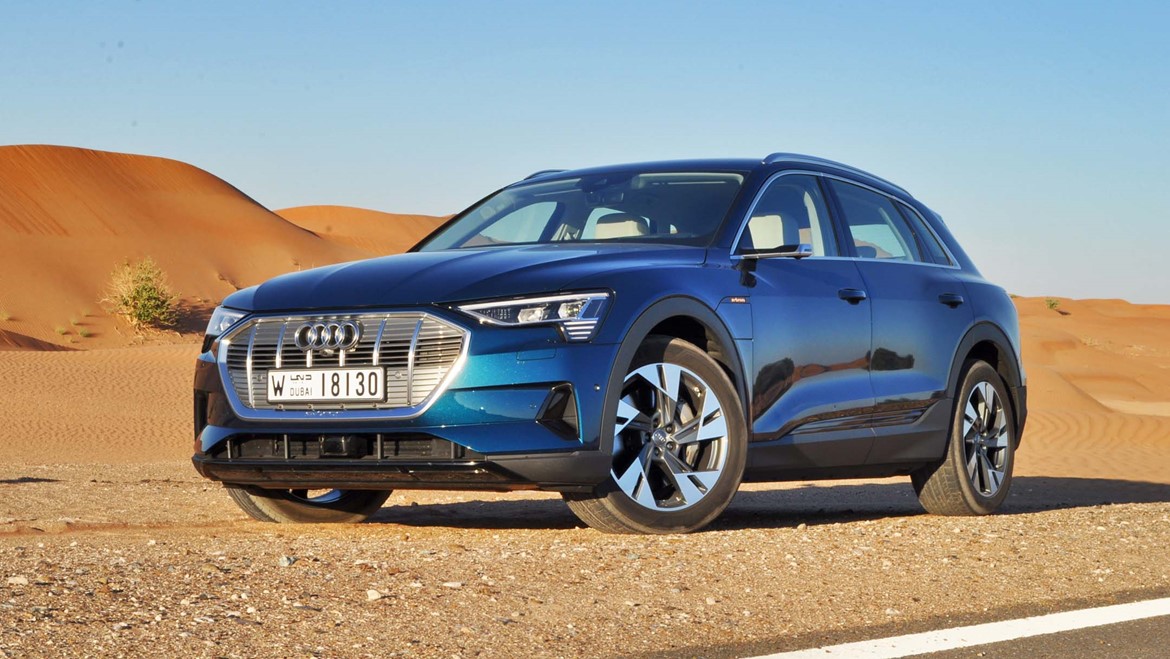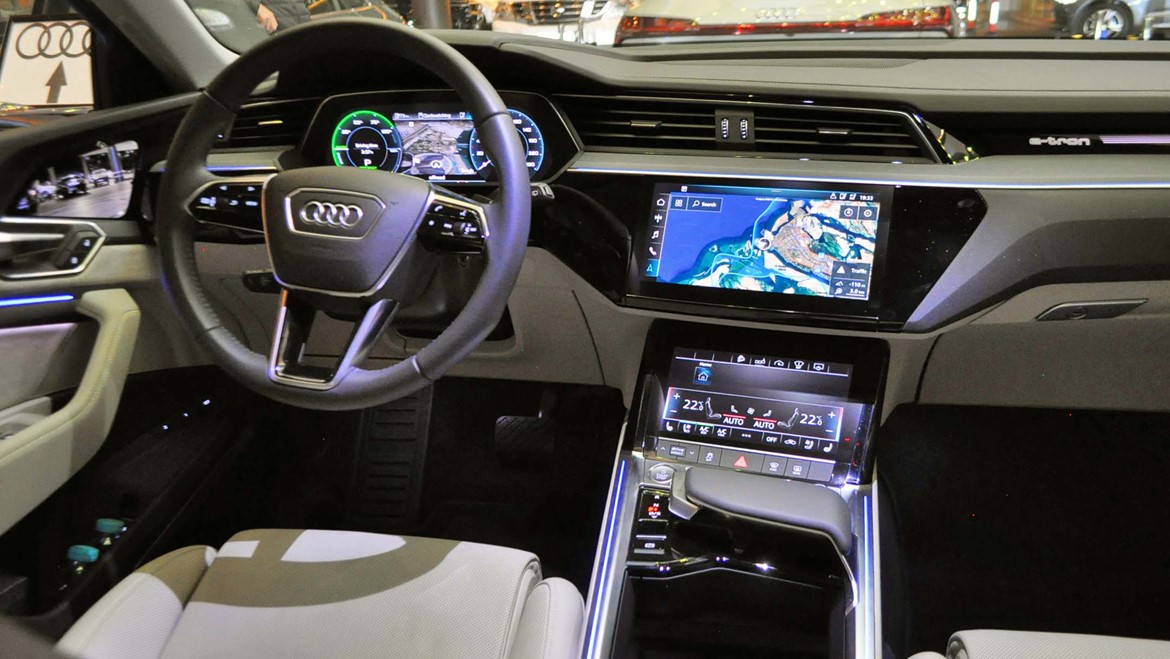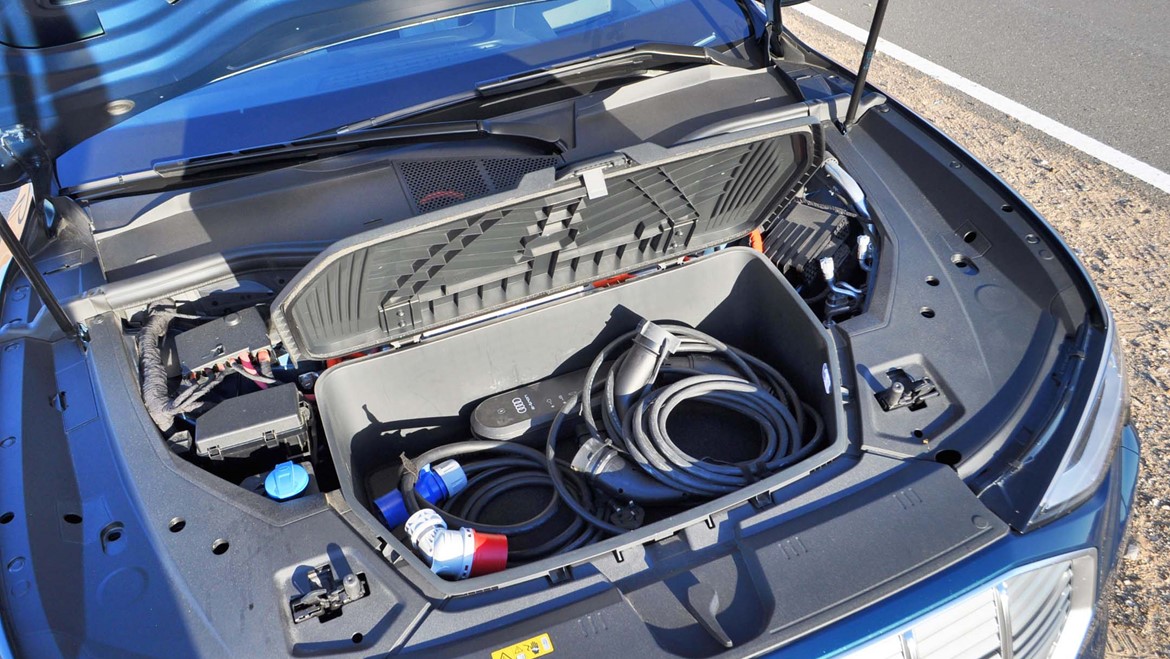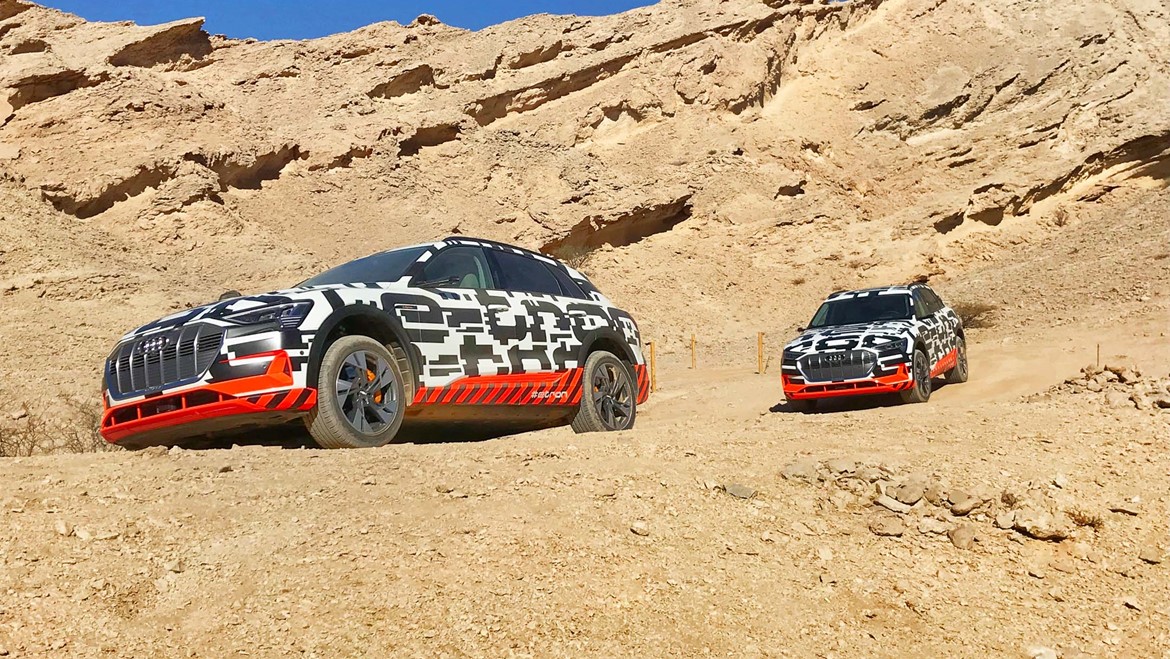
AutoTRADER.ca | Michael Bettencourt | 12/14/2018
ABU DHABI, UAE – Audi just launched its first all-electric production vehicle in a Middle Eastern country modernly built largely on oil product profits. As are Audi’s considerable profits, less directly, as they are largely based on selling vehicles that all require oil-based products to operate. Cue the irony.
That is, all of them used to use oil-based fuel, either gasoline or diesel. Audi’s recently discontinued A3 Sportback e-tron plug-in hybrid could be plugged in to provide a lowly 26 km of official electric range, but it too couldn’t be run without fuel in the gas tank.
But this all-new Audi e-tron SUV is different. It has no tailpipe. No gas or diesel tank anywhere, standard or on the options list. Power it up using electricity produced by renewable sources, as most of Canada’s power grid provides (outside Alberta and Saskatchewan especially), and you’re talking truly wells-to-wheels emissions-free driving – though this SUV e-tron’s buyers may be just as likely to appreciate the luxury of avoiding the weekly winter fill-up in freezing temperatures.
Plugging into a charging station in your own heated garage is a much more civilised undertaking.
Well, that won’t be happening much with e-tron buyers this winter, as the 2019 e-tron is expected to start arriving in spring 2019. That’s kind of late for a 2019 model, but may also be a blessing in disguise, as the all-new model only started production European models at Audi’s plant in Belgium in September 2018; the delay will hopefully give Audi time to sort out the type of software and production hiccups that have plagued automakers such as Tesla and Jaguar early in the production runs of their all-new battery-electric (BEV) models.
Range-topping SUV for Audi
At a starting price of $90,000, the e-tron becomes the most expensive SUV in Audi’s lineup, even moreso than the larger three-row Q7 and its new Q8 fastback sibling. That starting price puts the e-tron above the $77K cutoff for BC plug-in vehicle rebates, and with the death of EV incentives in Ontario (well, mostly), only Quebec e-tron buyers will be eligible for a provincial rebate – $3,000 for BEVs priced $75K–$125K.
Bottom line: don’t expect much government help towards the bottom line of this luxury SUV, at least as of this writing.
The e-tron falls between a Q5 and Q8 in size, but certainly closer to the generously roomy Q8 than the Q5 dimensions-wise (and price-wise, with the Q8 starting at $81,200). The e-tron’s main market rival will certainly be the Jaguar I-Pace, another all-electric SUV arriving for 2019, which is priced just below the Audi to start, but is also lower, shorter, and sportier than Audi’s e-tron.
Compared to that slinky I-Pace, which I had a chance to sample over a few days on cold Canadian roads just prior to attending the e-tron launch in balmy Abu Dhabi, the e-tron is all business. Its proportions are more square, in traditional SUV fashion, its glass at both ends less steeply raked than on the Jaguar. But it’s also less of a slave to bubbly aerodynamics than the Model X, which is larger and well over the $100K barrier, but is available with a third row, which neither the Audi nor Jag BEV SUVs offer.

The Audi does take some big swings at serious styling statements, with one of its signature styling cues unfortunately unavailable – yet – in North America. In Europe, all e-tron are offered with optional super slim rear-view camera “mirrors” instead of the usual exterior mirrors on both sides. Those cameras then project the view behind the car to a screen located just above and slightly ahead of the driver’s door handle, roughly in the line of sight if you were to turn towards that rear-view mirror.
Unfortunately, these signature exterior and interior options won’t be available in North America, at least at launch, as actual mirrors are legally mandated in this part of the world. Company execs say the lower aerodynamic drag of the smaller cameras provide up to three kilometres of extra range, which isn’t much, but are also quieter than the larger standard mirrors.
Audi is lobbying hard to update the legal standards or perhaps secure an exemption for the e-tron’s rear camera system, said Audi officials, but as we’ve seen with laser headlights, sometimes the technology progresses faster than the regulations that guide them. All of our test models at the launch featured the high-tech rear camera “mirrors,” and the designer that drove with us said it was one of the most challenging aspects of the overall interior’s design.
e-tron nails the SUV aspects, less so the range
The e-tron’s hefty 95 kWh battery provides an overall predicted range of 400 km, using the updated but still optimistic WLTP world rating standard. This is certainly enough range for most people to not only commute comfortably on even the coldest winter day in Canada, but also to have enough of a cushion for those busy winter and holiday weekends, where it’s tougher to know precisely how much range you’ll need for the day.
That said, its main Jaguar rival is WLTP-rated at 470 km worth of range from a smaller (90 kWh) battery, and in the most stringent/real-world rating out there in the EPA, the Jaguar clocks in at 377 km, as it does in its official Canadian range figure as well. So chances are the e-tron’s real-world figures will come in less than 400 km even in ideal conditions. This is supported by its range figure as listed at the start of our drive in a fully charged e-tron, which suggested a total range of 372 km on the dash – and that was with 26 degree Celsius temperatures.
Where Audi does have an advantage over both the Jaguar and the Tesla is the fact that it offers the fastest of all quick-charging systems. Its CCS 150 kW fast-charging system is the quickest currently on the market (well, almost on the market), which will allow it to charge its large battery from nearly zero up to 80 percent in 30 minutes, faster than the Jag, Tesla, or even the upcoming all-electric Mercedes-Benz EQC SUV.
The challenge for e-tron buyers will be to find a quick charger capable of charging at that 150 kW speed. The e-tron’s senior manager Johannes Eckstein said while none are currently available in Canada, there are plans to establish a network of such high-speed and more common L2 chargers as part of Electrify Canada, a new company formed by Volkswagen Group Canada. They have committed to launching the first sites right around the time the e-Tron launches in the second quarter of 2019.

By the end of 2019, said Eckstein, Audi expects 32 separate sites to be established near major cities in Canada, including from the Detroit/Windsor to Montreal corridor along the 401, as well as from Vancouver and into the Rockies in Alberta. Each of the sites are expected to have six to eight stations, with both CCS and CHAdeMO quick chargers available, with the goal now still to offer at least one 150 kW charger at each site, said Eckstein, and up to 128 DC charging stations capable of even higher 350 kW charging speeds.
This will help the practicality of long trips in the all-electric e-tron, and like Tesla’s increasingly common (and currently fastest) Supercharger stations, could become a key advantage for Audi and the e-tron, as well as other high-end electric products coming from the VW Group, including the e-Tron Sportback and Porsche Taycan.
That practicality aspect is key for the e-tron, as it’s clear that Audi is targeting non-electric luxury SUV buyers and owners here, and not just EV early adopters. So the taller body allows generous headroom and a more commanding view out the windshield, while its generous dimensions offer plenty of elbow room in front and back as well. The cargo area is totally flat, thanks in part to the skateboard battery layout that’s becoming the accepted gold standard in BEV configurations, allowing for a generous 660 litres’ worth of cargo volume, or more than the three-row Audi Q7’s cargo bay with all the seats up.
The e-tron’s all-new interior is as futuristic as the drivetrain, with a unique three-button shifter that includes a leather-lined bridge that reminds one of a boxer’s taped-up right hand. The Park button is right at this boxer’s right thumb, with nearby buttons handling Reverse, Drive, and Sport mode.
Performance impressive, not class-leading
That Sport mode gives the e-tron a maximum of 402 hp and 490 lb-ft of torque, and though it’s as super quiet as most all-electric luxury vehicles, it feels especially refined if not quite so enthusiastically responsive as its BEV luxury SUV rivals. That power translates to a 0–100 km/h time of 5.7 seconds, roughly a second behind the Jag’s time. These e-Tron numbers are impressive figures for most luxury SUVs, especially one that sips fuel at roughly the equivalent of 2.5 L/100 km, which makes luxury plug-in hybrid SUVs from Volvo and BMW seem positively gluttonous and raucous in comparison.
From a handling standpoint, the Audi is once again impressive overall, but aimed more at overall comfort than corner carving, especially compared to the lower and more powerful Jaguar. We tackled some corners in the mountains outside the city center, and while it responded well to vigorous inputs, Audi clearly left some room for upgrades on the performance side of the e-tron.
But then most luxury buyers don’t buy high-end SUVs for their handling prowess, but more for their upscale styling inside and out, all-wheel drive all-weather capabilities – in which the e-AWD e-tron also excels – and overall practicality.
In all those areas, the e-tron provides the design and traditional luxury SUV appeal, complete with the high-tech driving feel and advanced technology inside that make driving a BEV so unique. And unlike some other luxury automakers, Audi is marketing the e-tron heavily to mainstream audiences, suggesting it is not jumping into the segment to simply provide a PR talking point or improve its corporate fuel economy average, but to become a serious player in the all-electric market.
Pricing: 2019 Audi e-tron
Audi e-tron 55 quattro: $90,000
Source: https://www.autotrader.ca/expert/20181214/first-drive-2019-audi-e-tron/

